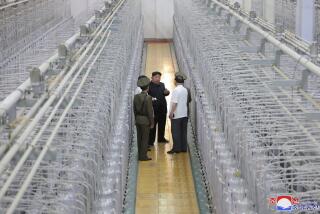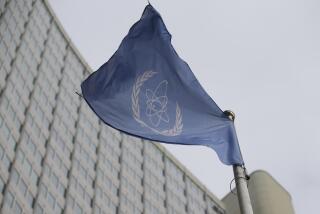Iran has enough fuel for a nuclear bomb, report says
TEHRAN — Iran has enough nuclear fuel to build a bomb if it decides to take the drastic steps of violating its international treaty obligations, kicking out inspectors and further refining its supply, U.N. officials and arms control experts said Thursday.
Iran has made no such gestures and has slowed its expansion of machinery producing nuclear fuel, having increased production capacity by less than 5% over the last three months, according to a report issued Thursday by the International Atomic Energy Agency.
Another IAEA report released Thursday raises suspicions about graphite and uranium particles found at an alleged nuclear site in Syria that was bombed by Israel in 2007.
The reports, the latest updates from the arms control watchdog for the United Nations, show that Iran had amassed about 2,227 pounds of low-enriched, or reactor-grade, nuclear fuel by late January. Physicists estimate that producing the 55 pounds or so of highly enriched, or weapons-grade, uranium needed for an atomic warhead requires 2,205 to 3,748 pounds of low-enriched uranium.
Iran’s increased supply of low-enriched uranium surprised diplomats and arms control experts who had assumed that Iran would need until the end of the year to acquire enough fuel for a bomb.
One expert, David Albright of the Washington-based Institute for Science and International Security, said he was “blindsided” by the report.
“We are surprised,” Albright said. “We did not expect this.”
Senior officials close to the Vienna-based IAEA told reporters and arms control experts in a conference call Thursday evening that Iranian officials said they had “miscalculated” their stockpile of low-enriched uranium, an error that was cleared up with agency officials in mid-November but never made public.
Iran steadfastly denies that it hopes to build an atomic bomb, which the country’s supreme leader, Ayatollah Ali Khamenei, says violates the principles of Islam. It says its nuclear program is intended solely to produce energy for Iran’s growing population.
But the United States, Europe and Israel suspect Iran is trying to attain a nuclear weapons capacity that could have strategic implications for the Middle East.
By crossing the 2,205-pound threshold, experts say, Iran has improved its “breakout” capacity, the ability to renege on treaty obligations, kick out inspectors and quickly build a bomb.
The latest IAEA report may complicate the Obama administration’s plan to engage diplomatically with the Islamic Republic in an attempt to persuade it to dismantle sensitive elements of its nuclear program.
Still, Albright said, the uranium stockpile signifies “a capability, not a decision.” And even if Iran made such a decision, it would face numerous major hurdles to building a bomb.
For one thing, it doesn’t have enough high-speed centrifuges at its facility in Natanz to further refine the uranium, said senior U.N. officials, who spoke on condition of anonymity.
“In theory it is possible,” one official said. “But to do so they would have to use installed capacity. If they would use the facility in Natanz, they’re not there.”
The IAEA report, distributed to members of the agency’s board before a March 2 meeting, also says inspectors found no evidence that Iran was trying to further refine the nuclear fuel, which remains under constant surveillance, or to move it to another facility.
But Iranian officials have barred inspections of facilities producing centrifuge parts, a move arms control inspectors say adds to worries that Iran may build an undeclared centrifuge facility separate from Natanz.
Since November, Iran has added only one new 164-centrifuge cascade at Natanz, suggesting it was slowing the acceleration of its program. About 4,000 centrifuges are now producing nuclear fuel at the facility, with 1,600 more installed but not yet operating, according to the report, which was obtained by The Times.
Iran has also barred inspectors from its heavy-water reactor near Arak, which has concerned inspectors who hope to examine the site for possible telltale “clandestine” features that could be used in a weapons program, said a high-ranking U.N. official.
The report also takes Iran to task for refusing to answer questions about a set of classified documents that arms control experts say suggest Iran engaged until 2003 in missile design, radiation experiments and explosives testing consistent with a covert nuclear weapons program. Iran says the documents, dubbed the “alleged studies” by diplomats and arms control experts, are forgeries.
The agency’s report on Syria criticizes Damascus for limiting access to the bombed facility near Dair Alzour, which Syrian authorities say was an unused military site, as well as other facilities. Graphite is often used to build a nuclear reactor, but U.N. officials said they could not yet say whether the graphite traces found were nuclear-grade.
Syria has said that artificially modified uranium particles at the site probably came from Israeli bombs. But the IAEA report says the composition of the particles suggests “a low probability” that they came from munitions.
A senior U.N. official told reporters the uranium had been oxidized. Albright said metallic uranium found in reactors would have been oxidized if it was blown up in an airstrike, suggesting that uranium fuel could have been present at the remote Syrian site.
U.S. intelligence officials have maintained that no nuclear material had yet been introduced at the site at the time it was bombed by Israel.
--
More to Read
Sign up for Essential California
The most important California stories and recommendations in your inbox every morning.
You may occasionally receive promotional content from the Los Angeles Times.










